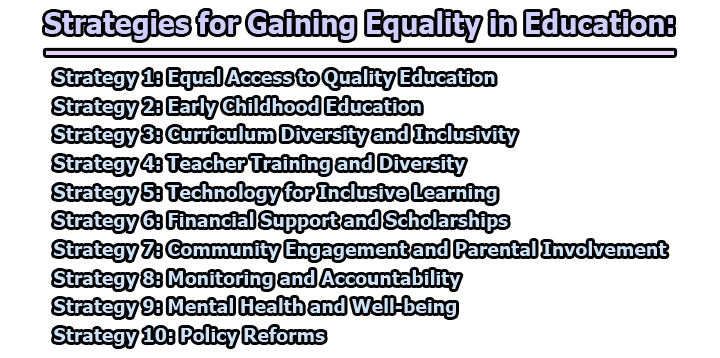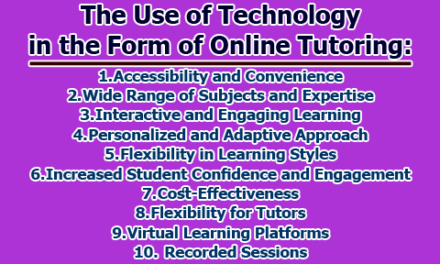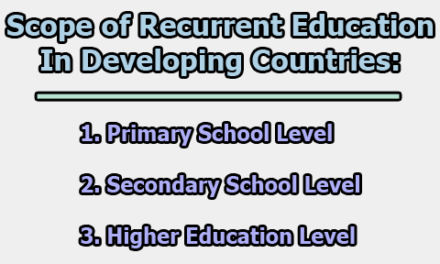Strategies for Gaining Equality in Education:
Education is the cornerstone of personal and societal development, yet inequalities persist in educational systems worldwide. Achieving equality in education is not only a moral imperative but also crucial for fostering innovation, economic growth, and social cohesion. In this article, we will explore the key strategies for gaining equality in education, addressing both systemic and individual challenges.
Strategy 1: Equal Access to Quality Education:
1.1 Resource Allocation: Ensure that educational resources are distributed equitably among all schools. This includes funding, teaching materials, technology, and extracurricular opportunities. Schools in underprivileged areas should receive additional support to bridge resource gaps.
1.2 Infrastructure Improvement: Address disparities in physical infrastructure by investing in the construction and maintenance of school buildings, classrooms, and other facilities. This helps create a conducive learning environment for all students.
1.3 Qualified Teachers: Implement policies to attract and retain qualified teachers in schools serving marginalized communities. Offer competitive salaries, professional development opportunities, and incentives to educators who choose to work in areas with educational challenges.
1.4 Transportation Accessibility: Address transportation barriers by providing affordable and reliable transportation options for students in remote or economically disadvantaged areas. This ensures that all students can access schools without facing unnecessary challenges.
1.5 Special Education Inclusion: Develop inclusive educational practices to accommodate students with diverse learning needs. This includes providing support services, adaptive technologies, and specialized teacher training to create an environment where every student can thrive.
Strategy 2: Early Childhood Education:
2.1 Universal Pre-K Programs: Establish universal pre-kindergarten programs to ensure that all children have access to early education. This helps level the playing field by providing a foundation for cognitive, social, and emotional development.
2.2 Community Outreach: Conduct targeted community outreach programs to inform parents about the importance of early childhood education. This can include workshops, informational sessions, and partnerships with community organizations to promote awareness.
2.3 Home Visits: Implement home visitation programs to connect educators with parents and caregivers. These visits can facilitate early intervention, assess the home environment, and provide parents with resources to support their child’s development.
2.4 Collaboration with Childcare Providers: Establish collaborations with private and community-based childcare providers to ensure a seamless transition to formal education. This involves sharing best practices, aligning curricula, and fostering a cohesive early learning experience.
2.5 Focus on Holistic Development: Emphasize a holistic approach to early childhood education, incorporating social-emotional learning, physical activities, and creative expression. This ensures that children develop a broad set of skills that will serve as a strong foundation for future learning.
Strategy 3: Curriculum Diversity and Inclusivity:
3.1 Representation in Educational Materials: Ensure that educational materials, textbooks, and curricula reflect the diversity of cultures, races, and experiences. This helps students see themselves in their learning materials, fostering a sense of belonging.
3.2 Culturally Responsive Teaching: Provide training for educators in culturally responsive teaching methods. This includes understanding and valuing students’ cultural backgrounds, incorporating diverse perspectives, and creating an inclusive classroom environment.
3.3 Multilingual Education: Support multilingual education programs to address language barriers for students from non-dominant language backgrounds. This can involve bilingual instruction, language support services, and promoting the preservation of indigenous languages.
3.4 Inclusive History Education: Revise history curricula to include accurate and diverse narratives that represent the experiences of marginalized communities. This helps counteract historical biases and fosters a more comprehensive understanding of the world.
3.5 Diversity in Literature and Arts: Encourage the inclusion of diverse voices in literature, arts, and other cultural expressions within the curriculum. This broadens students’ perspectives and contributes to a more inclusive and enriched learning experience.
Strategy 4: Teacher Training and Diversity:
4.1 Diversity Training Programs: Implement mandatory diversity, equity, and inclusion training programs for teachers and school staff. This training should cover topics such as cultural competency, unconscious bias, and creating an inclusive classroom environment.
4.2 Recruitment from Diverse Backgrounds: Actively recruit teachers from diverse backgrounds to create a teaching workforce that reflects the student population. This can be achieved through targeted recruitment efforts, scholarships, and mentorship programs for aspiring educators from underrepresented groups.
4.3 Professional Development: Offer ongoing professional development opportunities for teachers to enhance their skills in addressing the diverse needs of students. This includes training on differentiated instruction, inclusive teaching practices, and effective strategies for reaching all learners.
4.4 Cultivate Inclusive School Culture: Foster an inclusive school culture that values diversity and promotes collaboration among teachers, students, and parents. This involves creating spaces for open dialogue, celebrating cultural events, and addressing issues related to bias or discrimination promptly.
4.5 Mentorship Programs: Establish mentorship programs that pair experienced educators with new teachers, especially those from underrepresented backgrounds. This not only supports professional growth but also creates a sense of community within the teaching staff.
Strategy 5: Technology for Inclusive Learning:
5.1 Digital Accessibility Standards: Implement and enforce digital accessibility standards to ensure that educational technology is usable by all students, including those with disabilities. This involves designing software, websites, and online content with features that accommodate various needs.
5.2 One-to-One Device Initiatives: Advocate for one-to-one device initiatives to provide students with personal digital devices, ensuring that they have equal access to online educational resources and tools. This is particularly important in economically disadvantaged areas.
5.3 Internet Connectivity Programs: Collaborate with internet service providers and government agencies to implement programs that offer affordable or subsidized internet connectivity to households lacking access. This addresses the digital divide and allows all students to participate in online learning.
5.4 Digital Literacy Education: Integrate digital literacy education into the curriculum to empower students with the skills needed to navigate the digital world. This includes critical thinking about online information, responsible social media use, and cybersecurity awareness.
5.5 Adaptive Learning Platforms: Utilize adaptive learning platforms that cater to individual learning styles and abilities. These platforms can provide personalized learning experiences, allowing students to progress at their own pace and receive targeted support where needed.
Strategy 6: Financial Support and Scholarships:
6.1 Need-Based Financial Aid: Establish need-based financial aid programs to support students from low-income families. This can include tuition assistance, textbook stipends, and financial support for extracurricular activities.
6.2 Merit-Based Scholarships: Create merit-based scholarship opportunities to recognize and reward academic achievement, regardless of socio-economic background. These scholarships can motivate students to excel in their studies and pursue higher education.
6.3 Corporate and Community Partnerships: Foster partnerships with corporations, foundations, and community organizations to secure financial support for educational initiatives. This collaborative approach can help raise funds for scholarships and other essential resources.
6.4 Transparent Financial Aid Processes: Ensure transparency in the financial aid application process, making it accessible and understandable for all families. Provide guidance and assistance to parents and students to navigate the application procedures.
6.5 Address Hidden Costs: Identify and address hidden costs associated with education, such as transportation, uniforms, and school supplies. Implement measures to alleviate these financial burdens for families, ensuring that all students can fully participate in their educational journey.
Strategy 7: Community Engagement and Parental Involvement:
7.1 Parent-Teacher Partnerships: Encourage strong partnerships between parents and teachers through regular communication channels. This includes parent-teacher conferences, newsletters, and digital platforms to keep parents informed about their child’s progress and school activities.
7.2 Parent Education Workshops: Conduct workshops and informational sessions for parents on topics such as the importance of education, effective parenting strategies, and how to support their child’s learning at home. Empower parents to actively engage in their child’s education.
7.3 Community Events and Activities: Organize community events and activities that bring together educators, students, and parents. These events can strengthen community bonds, create a supportive network, and foster a sense of belonging for all stakeholders.
7.4 Parental Involvement in Decision-Making: Actively involve parents in decision-making processes related to school policies, curriculum development, and resource allocation. This participatory approach ensures that the diverse needs of the community are considered.
7.5 Cultural Competency Training: Provide cultural competency training for educators to enhance their understanding of diverse family backgrounds. This promotes respectful and inclusive interactions between teachers and parents, bridging cultural gaps and building trust.
Strategy 8: Monitoring and Accountability:
8.1 Data Collection and Analysis: Implement robust data collection systems to monitor educational outcomes, identifying disparities based on factors such as race, socio-economic status, and gender. Regularly analyze this data to inform policy decisions and interventions.
8.2 Standardized Testing Reforms: Evaluate and reform standardized testing practices to ensure that they do not perpetuate inequalities. Consider alternative assessment methods that provide a more comprehensive understanding of students’ abilities and potential.
8.3 School Performance Reviews: Conduct regular performance reviews of educational institutions, taking into account their efforts to promote diversity, equity, and inclusion. This evaluation should inform resource allocation and support mechanisms for schools in need.
8.4 Community Scorecards: Develop community scorecards that provide transparent information on educational outcomes, resource distribution, and school policies. This empowers communities to advocate for necessary changes and hold educational institutions accountable.
8.5 Equity Audits: Conduct equity audits to assess the impact of policies and practices on different student groups. Identify and address systemic barriers that contribute to disparities in educational outcomes.
Strategy 9: Mental Health and Well-being:
9.1 Comprehensive Mental Health Programs: Implement comprehensive mental health programs within schools to address the emotional well-being of students. This includes counseling services, peer support groups, and awareness campaigns to reduce stigma.
9.2 Teacher Training on Mental Health: Provide teachers with training on recognizing and addressing mental health issues in students. Equip educators with the skills to create a supportive and empathetic learning environment.
9.3 Collaboration with Mental Health Professionals: Establish partnerships with mental health professionals and organizations to offer specialized support for students facing mental health challenges. This collaboration ensures a holistic approach to student well-being.
9.4 Inclusive Well-being Education: Integrate well-being education into the curriculum, covering topics such as stress management, resilience-building, and coping strategies. This empowers students with the tools to navigate challenges and thrive academically.
9.5 Anti-Bullying Initiatives: Implement anti-bullying initiatives to create a safe and inclusive school environment. Train staff and students on recognizing and preventing bullying, fostering a culture of respect and acceptance.
Strategy 10: Policy Reforms:
10.1 Equity-focused Policies: Advocate for the development and implementation of policies that explicitly prioritize equity in education. Work with policymakers to create a framework that addresses systemic issues, allocates resources equitably, and promotes inclusive practices.
10.2 Legislation Against Discrimination: Lobby for legislation that prohibits discrimination in education based on factors such as race, gender, socio-economic status, and disability. These legal measures provide a foundation for enforcing equal opportunities for all students.
10.3 Review and Revise Funding Models: Assess and revise funding models for schools to ensure that resources are distributed fairly. This may involve a shift towards needs-based funding and addressing historical inequities in resource allocation.
10.4 Inclusive Curriculum Policies: Develop policies that mandate the inclusion of diverse perspectives in educational curricula. This ensures that students are exposed to a broad range of experiences and cultures, promoting understanding and empathy.
10.5 Community Advocacy: Empower communities to advocate for policy changes by providing resources, training, and a platform for their voices to be heard. Community involvement strengthens the grassroots movement for educational equity.
In conclusion, gaining equality in education requires a multifaceted approach that addresses not only systemic issues but also individual needs and circumstances. By implementing above strategies, we can work towards building a more inclusive and equitable educational system that empowers every student, regardless of their background, to reach their full potential. Education should be a catalyst for social change, and by embracing these strategies, we can move closer to a future where everyone has equal access to quality learning opportunities.
Frequently Asked Questions (FAQs):
Why is achieving equality in education important?
Achieving equality in education is important for several reasons. It ensures that every individual, regardless of their background, has equal access to opportunities for personal and societal development. Education is a key driver of social mobility, economic growth, and innovation, and by promoting equality, we create a more just and inclusive society.
How can technology contribute to inclusive learning in education?
Technology can contribute to inclusive learning by providing equal access to educational resources. This includes online learning platforms, digital textbooks, and adaptive technologies that cater to diverse learning styles and abilities. Additionally, technology can facilitate remote learning, overcoming geographical barriers and providing education to students in underserved areas.
What role do parents play in promoting equality in education?
Parents play a crucial role in promoting equality in education. Their involvement in their child’s education, participation in school activities, and advocacy for inclusive policies contribute to a supportive learning environment. Engaged parents can also collaborate with educators to address systemic issues and ensure that all students receive equal opportunities.
How can policymakers contribute to achieving educational equity?
Policymakers can contribute to achieving educational equity by implementing and supporting policies that prioritize equality. This includes funding models that address resource disparities, legislation against discrimination, and initiatives promoting diversity in schools. Policymakers can also collaborate with educators, communities, and advocacy groups to address systemic issues.
How can schools foster an inclusive culture?
Schools can foster an inclusive culture by promoting diversity in curricula, implementing anti-bullying initiatives, and providing professional development for teachers on cultural competency. Creating safe and welcoming spaces, involving parents in decision-making, and celebrating cultural events contribute to an inclusive school culture.
What are the challenges in achieving equality in education?
Challenges in achieving equality in education include systemic barriers such as unequal resource distribution, discrimination, and socioeconomic disparities. Additionally, cultural biases, lack of awareness, and resistance to change can pose obstacles. Overcoming these challenges requires a comprehensive and collaborative approach involving educators, policymakers, communities, and various stakeholders.
How can communities contribute to educational equity?
Communities can contribute to educational equity by actively engaging in their local schools, advocating for inclusive policies, and supporting initiatives that address the unique needs of their community. Community involvement, including volunteering, mentorship programs, and participation in school governance, helps create a sense of shared responsibility for educational outcomes.
What is the role of teacher diversity in promoting equality in education?
Teacher diversity is essential for promoting equality in education. A diverse teaching workforce reflects the student population, providing role models and fostering cultural understanding. Teachers from diverse backgrounds can bring varied perspectives, enriching the learning experience and contributing to a more inclusive educational environment.
How can technology address the digital divide in education?
Technology can address the digital divide by promoting initiatives such as one-to-one device programs, affordable internet access, and digital literacy education. Additionally, the development of accessible online resources ensures that all students, regardless of economic status or geographical location, can benefit from digital learning opportunities.
What are some successful examples of countries or regions achieving educational equity?
Several countries and regions have implemented successful strategies for achieving educational equity. Examples include Finland, which emphasizes a comprehensive and equal education system, and Singapore, which focuses on quality teaching and student support. These success stories often involve a combination of equitable funding, teacher training, inclusive policies, and community engagement.

Assistant Teacher at Zinzira Pir Mohammad Pilot School and College










